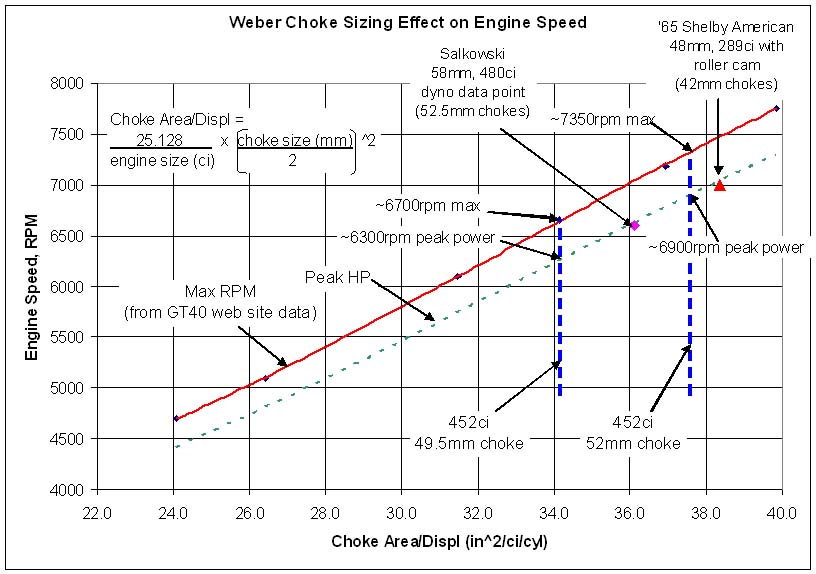 
 Main Menu
Main Menu
|
 Nevada Classics
Nevada Classics
|
 Advertise at CC
Advertise at CC
|
| S |
M |
T |
W |
T |
F |
S |
| |
1 |
2 |
3 |
4 |
5 |
6 |
| 7 |
8 |
9 |
10 |
11 |
12 |
13 |
| 14 |
15 |
16 |
17 |
18 |
19 |
20 |
| 21 |
22 |
23 |
24 |
25 |
26 |
27 |
| 28 |
29 |
30 |
31 |
|
|
|
|
 CC Advertisers
CC Advertisers
|
|

08-13-2009, 09:28 AM
|
 |
CC Member

|
|
|
Join Date: May 2001
Location: California,
Ca
Cobra Make, Engine: NAF 289 Slabside Early Comp Car with 289 Webers and all the goodies. Cancelling the efforts of several Priuses
Posts: 6,592
|
|

 Not Ranked
Not Ranked

One thing that I realized had not been openly discussed was the elevation that we individually live at, it certainly has some distinct effect on what variables are applied to our particular application.
I would agree with Gaz64; thel least amount of fuel injected by the accelerator pumps the better. If the E-tubes are lean in transition and cause a stumble, the most common Band Aid is to dump fuel with the acclerator pump circuit in an effort to rid yourself of the carb sneezing.
If you are using carbs that are not "New" the fitament of the Aux venturis in the Carb body must be checked. It is imperative that there be a tight fit to effect a seal in the fuel passage from the Main Well to the Aux Venturi, if you can gently wiggle the venturi there will be a leak that will cause all sorts of transition problems, check it on each carb. Sometimes the small spring clip on the venturi becomes loose and does not exert sufficient force to keep a tight seal, there is a fix for this and it should be considered.
__________________
Rick
As you slide down the Banister of Life, may the splinters never be pointing the wrong way 
Last edited by Rick Parker; 08-13-2009 at 09:37 AM..
|

08-13-2009, 02:34 PM
|
 |
CC Member

|
|
|
Join Date: May 2008
Location: Brisbane,
QLD
Cobra Make, Engine:
Posts: 2,797
|
|

 Not Ranked
Not Ranked
It does seem the more reading one does, the more confusing it becomes as well.
The above listing shows F8 richer than F7 yet the hole placement is contradictory to this.
F2 would be richer than F11 because it's smaller in diameter.
Agree with grouping them via diameter first, then step placement, then hole placement.
But then you end with a lot of groups, it still may help to list them correctly from rich to lean.
And the yes the camshaft does have a greater influence on airflow, I guess it's the combination of capacity, compression and camshaft. 
__________________
Gary
Gold Certified Holden Technician
|

08-13-2009, 02:55 PM
|
 |
CC Member

|
|
|
Join Date: Mar 2004
Location: miami,
FL
Cobra Make, Engine: E-M Cobra Ford FE 427 w/ Webers 48 IDA
Posts: 1,383
|
|

 Not Ranked
Not Ranked

Well,
I think once you break them down into the 3 groups, you can pretty much pick any tube from any group to get a feel for which group of tubes you will need to stay within.
Once you ave figured this out then you can make a determination whether to go rich or lean in that group. 
If you decide to change the choke to a larger or smaller choke, you should still stay with your grouping to to not complicate the matter. (I have not tried this experient yet).
On another note: What is the recommended choke to be used on the 390, 427, + engines.
I have herd that the 48 mm are too small for the BB motors. However by looking at a chart it looks like 42 - 44 mm choke should be just right. If it is a street car or road race side on the small part of the choke selection.
Also, if you run these 52 mm carb bodies what difference will make if you put the 40 mm choke back in it.
Aren't you just restricting the carbs right back down to the size of the choke?
And why not remove the choke all together on the 48 mm bodies, the horns will correct the intial entry of the air flow.
Just questions I have?
Last edited by priobe; 08-13-2009 at 03:01 PM..
|

08-13-2009, 03:30 PM
|
|
CC Member

|
|
|
Join Date: Aug 2007
Cobra Make, Engine: 31XX Car
Posts: 374
|
|

 Not Ranked
Not Ranked
 Choke Sizing
Choke Sizing
Probably just wasting my time posting it, but here goes:

You can back calculate the choke size by picking an appropriate point on the line and then rearrange the equation (plugging in your displacement). |

08-13-2009, 03:59 PM
|
 |
CC Member

|
|
|
Join Date: Mar 2004
Location: miami,
FL
Cobra Make, Engine: E-M Cobra Ford FE 427 w/ Webers 48 IDA
Posts: 1,383
|
|

 Not Ranked
Not Ranked
Wouldn't it be dependent on alot of factors rather than CI.
As example, camshaft spec, compression ratio, ported heads, valve size etc
I am just learning here, I dont mean to start a debate  |

08-13-2009, 04:08 PM
|
|
CC Member

|
|
|
Join Date: Aug 2007
Cobra Make, Engine: 31XX Car
Posts: 374
|
|

 Not Ranked
Not Ranked

Quote:
Originally Posted by priobe

Wouldn't it be dependent on alot of factors rather than CI.
As example, camshaft spec, compression ratio, ported heads, valve size etc:
|
Those factors would effect volumetric efficiency and airflow demand, so yes they have an impact, but probably more second order. It kind of already ties into the rpm demand, ie you couldn't have an engine that makes peak power at 7,000 rpm if it doesn't have good heads, cam, etc. The chart is intended as a ballpark. Some people are happy with engine configurations somewhat above or below this curve. I think it should be looked at as an indicator where if you have an engine which is stoutly built and you run chokes that plot to the left of the dashed curve, then you may have great off idle response, but you're most likely limiting your performance potential to a significant degree (and many in this category bad mouth webers for loosing steam at top end). Conversely, if you're running chokes that plot to the right of this curve, then you may be getting a few more HP at top end, but will generally have disproportionately poor low speed performance, including a much greater tendency for the legendary part throttle transition stumble (may not be important on a race car).

|

08-14-2009, 03:20 AM
|
 |
CC Member

|
|
|
Join Date: Sep 2006
Location: Skjetten,
No
Cobra Make, Engine: Unfortunataly ; none
Posts: 333
|
|

 Not Ranked
Not Ranked
 E- tubes
E- tubes
Agree some with those saying "the more I read, the more confused.....".
One of my Weber books , by PatBraden, have tables of e-tubes and tuning preference.
In one table F7 is said to be lean, in another "richer low end"...
Well; I run F11 in my IDF's on the 347. If I read GAZ64's table correct, this would be rather unusable (cylinder size 250- 325 ccm). But, my engine is running well, ableit a little rich (A/F 10,5- 12,5) on RPM range from 3000- 7500.
In all tables I have senn F11 is placed in the "normal use" group.
F2 I find under "Alcohol usage".... So, very rich, then?
If someone steps up and says "You should use F..", I'd go and buy a set . If then engine runs smoother and with more correct A/F than ever, I would really appreciate & look up to this person, indeed.
Anyone wants to make some definte conclusions on E-tubes?????
|

08-14-2009, 04:31 PM
|
 |
CC Member

|
|
|
Join Date: May 2008
Location: Brisbane,
QLD
Cobra Make, Engine:
Posts: 2,797
|
|

 Not Ranked
Not Ranked
Quote:
Originally Posted by Dcmgt

Probably just wasting my time posting it, but here goes:

You can back calculate the choke size by picking an appropriate point on the line and then rearrange the equation (plugging in your displacement). |
Hi, like others I can't understand the formula involved.
Can you elaborate on "^2"?
I can't seem to get any reasonable answer for my cars.
__________________
Gary
Gold Certified Holden Technician
|

08-14-2009, 06:43 PM
|
|
CC Member

|
|
|
Join Date: Aug 2007
Cobra Make, Engine: 31XX Car
Posts: 374
|
|

 Not Ranked
Not Ranked
 Chart
Chart
Gary - That means square the resulting value within the brackets.
We still need someone to model the emulsion tubes...........
|
| Thread Tools |
|
|
| Display Modes |
 Hybrid Mode Hybrid Mode
|
 Posting Rules
Posting Rules
|
You may not post new threads
You may not post replies
You may not post attachments
You may not edit your posts
HTML code is Off
|
|
|
All times are GMT -7. The time now is 02:49 PM.
Links monetized by VigLink
|


